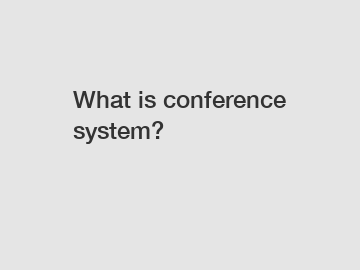What is conference system?
What is Conference System? And How Does it Work? .
A conference system is a communication platform that enables individuals to connect with each other from remote locations, allowing for seamless exchange of information and ideas. But what exactly is a conference system and how does it work? In this article, we will delve into the details of conference systems, explore their features and functionalities, and discuss their benefits and applications. So let's get started and unravel the world of conference systems!
1. Definition and Components of a Conference System:

A conference system is a technological solution designed to facilitate audio, video, and data communication among multiple participants at different locations. It typically comprises several essential components, including:
- Central Control Unit: Acts as the brain of the system, managing the audio and video signals, and controlling participant access and permissions.
- Microphones: Participants use microphones to transmit their voices to other participants.
- Speakers: Reproduce sound from remote participants to ensure everyone can hear clearly.
- Cameras: Capture video of the conference space or individual participants, allowing for visual communication.
- Display Screens: Show video feeds of participants or shared content, enhancing engagement and collaboration.
- Network Infrastructure: Enables the transmission of data over the internet or a dedicated network.
- User Interface: Allows participants to interact with the system, control audio and video settings, and manage conference activities.
2. How Does a Conference System Work?
Once all the necessary components are in place, the conference system operates as follows:
- Participants join the conference by logging into the system through their assigned user credentials.
- The central control unit establishes and manages connections between participants, ensuring proper routing of audio and video signals.
- Participants can communicate by speaking into their microphones, with their voices transmitted to other participants through speakers.
- Cameras capture video feeds, which are broadcast to other participants' display screens, enabling visual communication.
- Depending on the system's capabilities, participants may share content such as presentations or documents, enhancing collaboration.
- The central control unit coordinates the exchange of information, managing audio and video quality to ensure a smooth conference experience.
- Participants can actively engage in the conference, contributing ideas, asking questions, and participating in discussions.
3. Benefits of Using Conference Systems:
Conference systems offer a myriad of benefits, making them an indispensable tool for organizations and individuals alike. Some of the key advantages include:
- Enhanced Collaboration: Conference systems bridge geographical gaps, allowing teams situated in different locations to collaborate effectively.
- Time and Cost Savings: By eliminating the need for physical travel, conference systems help save time and reduce expenses associated with transportation and accommodation.
- Increased Productivity: The ability to organize impromptu or scheduled conferences without logistical challenges fosters efficiency, leading to enhanced productivity.
- Improved Communication: With audio and video capabilities, conference systems enable participants to communicate more effectively, capturing nuances that may be missed in written communication.
- Greater Engagement: Visual and audio cues facilitate active participation, enhancing engagement and fostering a sense of inclusivity among participants.
- Flexibility and Scalability: Conference systems can accommodate different numbers of participants and be customized to suit specific requirements, making them flexible and scalable.
4. Applications of Conference Systems:
Conference systems find application in various domains:
- Business Meetings: Organizations use conference systems for remote team meetings, client presentations, project updates, and training sessions.
- Educational Institutions: Schools, colleges, and universities leverage conference systems for virtual classrooms, online lectures, and student collaboration.
- Government and Public Sector: Conference systems facilitate remote government meetings, international collaborations, and public hearings.
- Healthcare: Medical professionals rely on conference systems for telemedicine consultations, remote diagnosis, and knowledge sharing among practitioners.
- Events and Conferences: Conference systems enable organizers to host virtual events and conferences, reaching a global audience without physical limitations.
In conclusion, a conference system is a powerful communication tool that connects individuals from different locations, facilitating effective collaboration and information exchange. With their numerous benefits and applications, conference systems have become a vital part of modern communication infrastructure. Whether for business, education, government, healthcare, or events, conference systems offer a seamless and immersive virtual meeting experience, breaking down barriers and enabling connections that transcend borders. So, next time you're planning a meeting or conference, consider harnessing the power of a conference system to bring people closer, regardless of their physical location.
For more information, please visit Ultra-thin Hd Lifting Screen, Conference Room Audio Video, Professional paperless conference system.

Comments